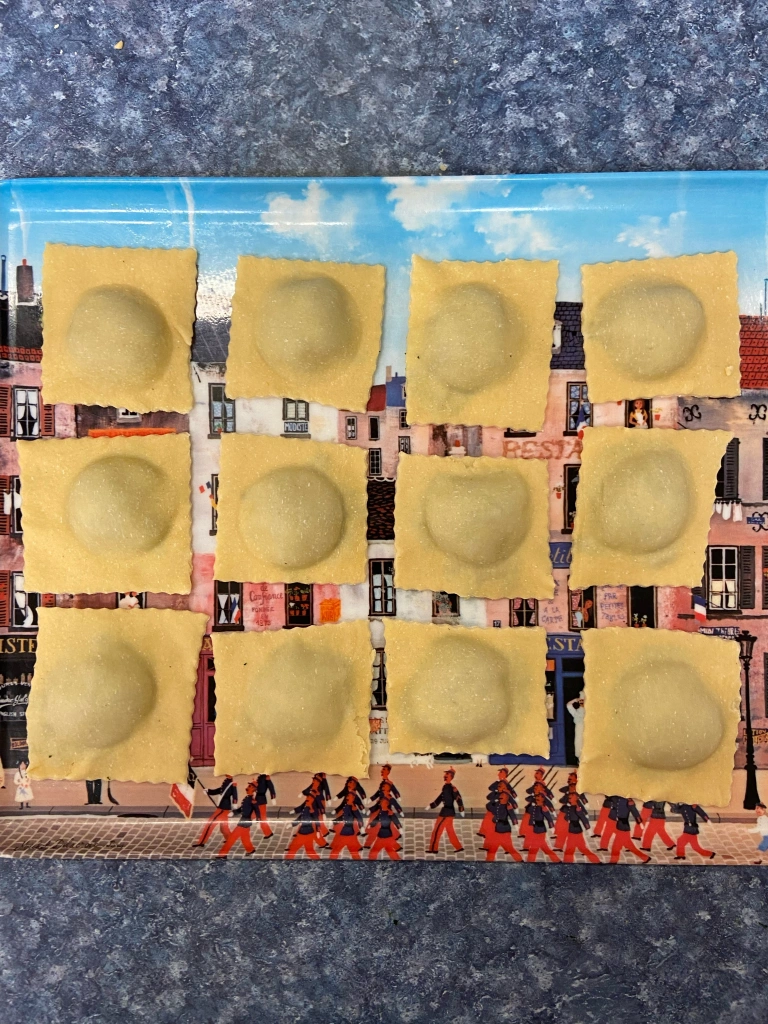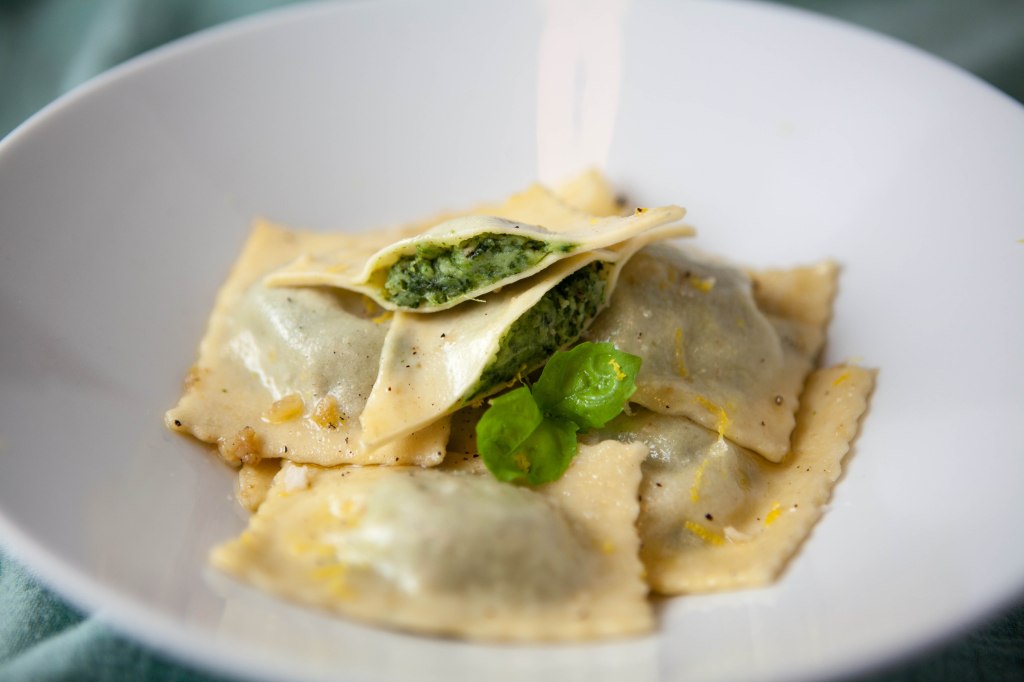It’s St. Patrick’s Day and although I don’t really have much of a connection to this day, I thought it would be fun to serve something festive for dinner.
I’ve made colcannon in the past, which is a traditional Irish potato dish with cabbage, and as I was leafing through an Alice Waters cookbook I saw a recipe for potato and spinach ravioli and I thought it would be the perfect dish for St. Patrick’s Day. I didn’t follow her recipe, but made up my own and after boiling the ravioli I sautéd them like pierogis.
Spinach and Potato ravioli in a garlicky cream sauce
Serves 4
Ingredients
For the pasta dough:
- 225 grams 00 flour
- 75 grams fine semolina flour
- 3 eggs
- 1 teaspoon olive oil
For the filling:
- 1 pound potatoes, any variety (I used a combination of russet, new potatoes and fingerling)
- 8 ounces frozen spinach, thawed and squeezed dry
- 1/3 cup grated Parmesan cheese
- 1 tablespoon butter
- 1/4 cup cream, divided
- salt and pepper, to taste
For the sauce:
- 1 tablespoon olive oil
- 1 tablespoon butter
- 2 cloves garlic, minced
- 1/4 cup cream
- salt and pepper, to taste
- zest of 1 lemon
Special supplies:
- Small food processor or immersion blender
- Potato ricer (you could use a potato masher but it won’t be as smooth)
- KitchenAid pasta roller adapter (or a hand cranked version would work too)
- Ravioli cutter (or a pizza cutter would work)
- Shot glass
- Large spider strainer (a slotted spoon would work)
Directions:
1. In a large bowl or on a clean, dry countertop, combine the flours. Make a well in the center and add the eggs and olive oil. Whisk the eggs and oil till scrambled, slowly incorporating the flour. Mix into a rough ball and knead for 10 minutes. Wrap in plastic wrap and set aside for at least 30 minutes.
2. Meanwhile, peel the potatoes and cut them into roughly the same sized pieces. Boil in salted water until tender, about 10-15 minutes. Place the squeezed spinach and 2 tablespoons of cream in a food processor and run it till the spinach is puréed. You may need to add a little more cream to get it going. When the potatoes are done, drain them and press through a potato ricer into a medium mixing bowl. Add the spinach, Parmesan, butter, remaining cream and salt and pepper. This should be a relatively homogenous consistency. Add more cream if necessary to make it smooth. Place mixture in a gallon zip top bag and refrigerate until cool.
3. Time to assemble the ravioli. Tear a small handful of dough away from your pasta ball and flatten it with your hand. Set the pasta roller on the largest setting and run the dough through. It’s ok if it tears apart a little. Roughly fold the dough into thirds and run it through again on the same setting. Repeat this three or four times until your dough is smooth.
4. Adjust the roller to the next thinnest setting and run the dough through once. Repeat this step making the roller thinner each time until you’ve run it through the thinnest setting.
5. Place the sheet of dough on a clean counter top. With a ravioli or pizza cutter, cut the sheet in half, across the width, not the length.
6. Cut a hole in the corner of the bag containing the filling and place about 1 teaspoon of filling on one half of the pasta sheet. Repeat so you have them evenly spaced on the dough, about 6-8 on the sheet. Place the other half of the dough on top and gently press the air out between the sheets without smashing down the filling. Use a shot glass to center the filling and lightly press down (don’t cut through the dough with the shot glass). This makes the ravioli look more uniform.
7. Use your ravioli cutter to cut out 6-8 ravioli. Pick up each ravioli and make sure the edges are sealed. Pinch any areas that look separated. Place on a semolina lined tray. Cover with foil.
8. Repeat steps 3-7 with the remaining dough and filling.
9. Bring a large pot of well-salted water to a boil. Just before the water is boiling, place a large sauté pan over medium-high heat and add the olive oil and butter. Add the garlic and cook till fragrant, turning down the heat to prevent the garlic from burning, about 1 minute. Add the cream, stir, and turn off the heat while you cook the ravioli.
10. Add the ravioli to the boiling water, gently stirring with a spider strainer. Boil the ravioli for 3-5 minutes, until al dente. Remove one ravioli and cut off a corner to see if the dough is cooked to your liking.
11. Heat the sauté pan again over medium-low heat. Remove the ravioli from the water using the spider strainer, give it a good shake to remove excess water, and place into the sauté pan. Gently toss the ravioli till they are all coated with the sauce. Add salt, pepper and lemon zest to taste. You could either serve right away or continue cooking the ravioli until they ever so lightly brown, like pierogis.
12. Serve the ravioli with a drizzle of cream and a grind of pepper.
















































